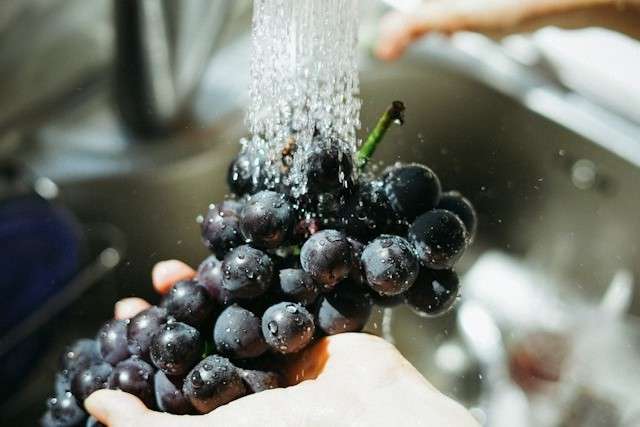Salmonella, Staphylococcus aureus, and Campylobacter are all really big names with pretty pictures – you can see them below. Don’t let those pretty pictures fool you. So why are they in this article and what do they have in common? They are some of the bacteria which can cause food poisoning, illness, hospitalization, and death. No Bueno.
Time to meet the players.
Let’s talk Salmonella.

Credit: WikiImages via Pixabay
Salmonella can cause diarrhea, fever, and stomach cramps. The good news is most people recover on their own without needing an antibiotic. The bad news is it can last four to seven days.
What about Staphylococcus aureus?

Credit: CDC
You can look forward to nausea, vomiting, and stomach cramps with possible diarrhea and, like Salmonella, it cannot be treated with an antibiotic. The bright side? The symptoms usually last about one day.
That leaves us with Campylobacter.

Credit: CDC
What goes on here? Bloody diarrhea, fever, and stomach cramps. You may also be looking at nausea and vomiting. Unfortunately, this one can cause severe complications. People with this infection can expect to be sick for about one week.
And we didn’t even mention Listeria. It’s one of the nastier players. When you hear of a food-related fatality, Listeria is often the cause.
Where The Food Comes From visited the University of Georgia (UGA) Center for Food Safety on July 11 to discuss foodborne illnesses. Thank goodness we also talked about how to prevent them and what scientists are doing about them.

How about some not so fun facts? There are about 48 million cases of foodborne illnesses in the United States annually – that’s roughly one in six Americans. Now you may be asking where does all this nastiness come from? It comes from poor handling and contamination of the foods we eat like produce, meat, fish, dairy and poultry. So basically, everything we all consume on a daily basis.

Chip’s first interview took place with the University of Georgia Center for Food Safety Director Professor Dr. Francisco Diez-Gonzalez. He explained the mission of the center is to study and control foodborne pathogens so no one gets sick from a foodborne illness. No easy task.

Dr. Francisco Diez-Gonzalez
Dr. Diez-Gonzalez gave Chip some very important scientific information. But there were a few things that struck me as totally fascinating. He explained the major causes of foodborne illnesses actually come from our own kitchens and how we handle our own food.

How many of you wash your fruits and vegetables by just rinsing them under running water?
I admit this is what I use to do but not now. By simply rinsing them under water you are likely to miss some of the surfaces of your fruit or vegetables that could be contaminated.


The solution is to put them in a bowl filled with water – you can also buy non-chlorine produce wash – and submerge and swish them around for about 30 seconds. Simple enough right?
What about defrosting meat?

Most likely some people defrost meat on their kitchen counters while others may put it in the sun. Well wrong again!
Yes, there is a proper way to defrost meat. Most of us know it but probably don’t do it. The answer is the refrigerator. By defrosting meat in the refrigerator, the internal temperature of the meat does not go above 40 degrees which happens to be too cold for bacteria to grow. Good to know. Just make sure you give yourself enough thaw time. An average size piece of meat usually requires a full day to defrost. Larger cuts of meat and whole turkeys and chickens take about 24 hours for every five pounds to defrost.
Now the biggie. Washing poultry.

I am going to go out on a limb here and say most of us wash the inside cavity, you know to get rid of what we think of as traces of blood and worse floating in it, and rinse and dry the outside of the poultry.
SUPER WRONG! Washing your poultry increases the risk of cross contamination by splashing contaminated microdroplets into the air that float and land onto all surfaces in your kitchen – counters, utensils, equipment, sponges etc. The best way to kill bacteria is cooking poultry thoroughly. And your best bet for that is to buy a good meat thermometer.
Hopefully goes without saying…

Credit: CDC
And hopefully by now everyone knows how important proper handwashing is to help prevent the spread of infection — if you don’t, just ask Google.
Back to the lab!
After this fascinating conversation Dr. Diez-Gonzalez took us to his research lab. He explained multiple experiments take place in designated areas. His explanations of all the experiments are so technical I am going to leave it to Chip’s interview in the episode.
But I do love a good lab and it was all I could do not to touch the beakers, pipettes, and petri dishes. I am sure I would have gotten a good reprimand for that.


One of Dr. Diez-Gonzalez‘s graduate assistants was working with petri dishes, spreading bacteria on an agar plate medium, otherwise known as a growth medium. Boy, I really wanted to get my hands on that. Again, likely to be reprimanded.
What is on todays menu?

Another player in foodbourne illness, Listeria monocytogenes. Credit: CDC
Next, we met another one of Dr. Diez-Gonzalez‘s graduate assistants Mayra Villar-Buzo. Myra is using a soft white cheese to create both good and bad bacteria. Once the petri dishes are completed the entire thing goes into an incubator to grow the bacteria. It has something to do with antibiotic resistance, I didn’t get it all but you will see it in the episode.

The beginning is not always before the end.
I have mentioned this before, but our shows aren’t necessarily filmed in the order you see them. In this case, the first scene was actually filmed last in the student breakroom. It was here we met Graduate Research Assistant Revati Narwankar.

It had been a long day and Chip needed a bite and I desperately needed a cup of coffee. Well, long story short Chip dropped whatever snack he chose, quickly picked it up and went to eat it. You know the good old 5-second rule – where if something is dropped on the floor its okay to consume it if you pick it up in 5-seconds or less. Side note: I have seen this rule applied to other things besides food.
Revati saw what Chip was going to do, came running in and stopped him — you’ll see it in the show. Hence, is there really a 5-second rule?
The answer is no surprise: You know better than that! Or will, once you see the show.


